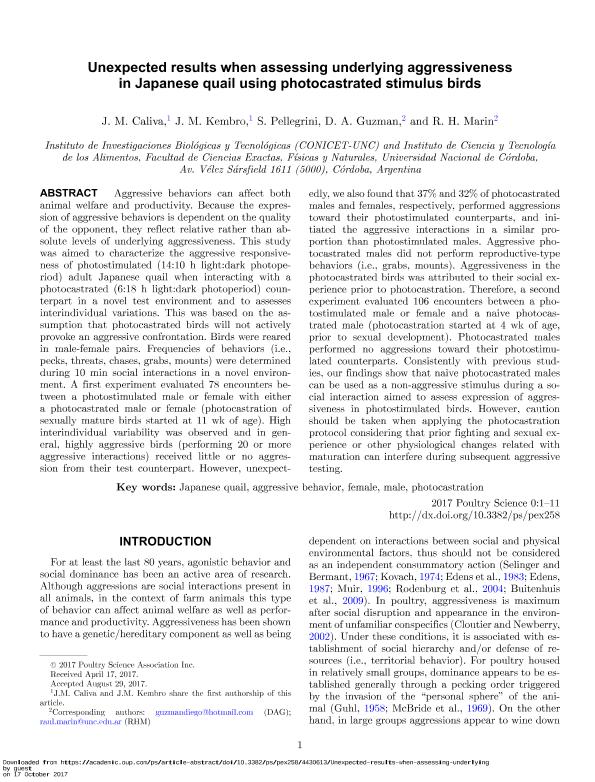Mostrar el registro sencillo del ítem
dc.contributor.author
Caliva, Jorge Martín

dc.contributor.author
Kembro, Jackelyn Melissa

dc.contributor.author
Pellegrini, Stefanía

dc.contributor.author
Guzmán, Diego Alberto

dc.contributor.author
Marin, Raul Hector

dc.date.available
2018-05-02T12:44:16Z
dc.date.issued
2017-12-01
dc.identifier.citation
Caliva, Jorge Martín; Kembro, Jackelyn Melissa; Pellegrini, Stefanía; Guzmán, Diego Alberto; Marin, Raul Hector; Unexpected results when assessing underlying aggressiveness in Japanese quail using photocastrated stimulus birds; Poultry Science Assoc Inc; Poultry Science; 96; 12; 1-12-2017; 4140–4150
dc.identifier.issn
0032-5791
dc.identifier.uri
http://hdl.handle.net/11336/43788
dc.description.abstract
Aggressive behaviors can affect both animal welfare and productivity. Because the expression of aggressive behaviors is dependent on the quality of the opponent, they reflect relative rather than absolute levels of underlying aggressiveness. This study was aimed to characterize the aggressive responsiveness of photostimulated (14:10 h light:dark photoperiod) adult Japanese quail when interacting with a photocastrated (6:18 h light:dark photoperiod) counterpart in a novel test environment and to assesses interindividual variations. This was based on the assumption that photocastrated birds will not actively provoke an aggressive confrontation. Birds were reared in male-female pairs. Frequencies of behaviors (i.e., pecks, threats, chases, grabs, mounts) were determined during 10 min social interactions in a novel environment. A first experiment evaluated 78 encounters between a photostimulated male or female with either a photocastrated male or female (photocastration of sexually mature birds started at 11 wk of age). High interindividual variability was observed and in general, highly aggressive birds (performing 20 or more aggressive interactions) received little or no aggression from their test counterpart. However, unexpectedly, we also found that 37% and 32% of photocastrated males and females, respectively, performed aggressions toward their photostimulated counterparts, and initiated the aggressive interactions in a similar proportion than photostimulated males. Aggressive photocastrated males did not perform reproductive-type behaviors (i.e., grabs, mounts). Aggressiveness in the photocastrated birds was attributed to their social experience prior to photocastration. Therefore, a second experiment evaluated 106 encounters between a photostimulated male or female and a naive photocastrated male (photocastration started at 4 wk of age, prior to sexual development). Photocastrated males performed no aggressions toward their photostimulated counterparts. Consistently with previous studies, our findings show that naive photocastrated males can be used as a non-aggressive stimulus during a social interaction aimed to assess expression of aggressiveness in photostimulated birds. However, caution should be taken when applying the photocastration protocol considering that prior fighting and sexual experience or other physiological changes related with maturation can interfere during subsequent aggressive testing.
dc.format
application/pdf
dc.language.iso
eng
dc.publisher
Poultry Science Assoc Inc

dc.rights
info:eu-repo/semantics/openAccess
dc.rights.uri
https://creativecommons.org/licenses/by-nc-nd/2.5/ar/
dc.subject
Japanese Quail
dc.subject
Aggressive Behavior
dc.subject
Female
dc.subject
Male
dc.subject
Photocastration
dc.subject.classification
Otras Ciencias Biológicas

dc.subject.classification
Ciencias Biológicas

dc.subject.classification
CIENCIAS NATURALES Y EXACTAS

dc.title
Unexpected results when assessing underlying aggressiveness in Japanese quail using photocastrated stimulus birds
dc.type
info:eu-repo/semantics/article
dc.type
info:ar-repo/semantics/artículo
dc.type
info:eu-repo/semantics/publishedVersion
dc.date.updated
2018-04-16T14:07:48Z
dc.identifier.eissn
1525-3171
dc.journal.volume
96
dc.journal.number
12
dc.journal.pagination
4140–4150
dc.journal.pais
Estados Unidos

dc.description.fil
Fil: Caliva, Jorge Martín. Consejo Nacional de Investigaciones Científicas y Técnicas. Centro Científico Tecnológico Conicet - Córdoba. Instituto de Investigaciones Biológicas y Tecnológicas. Universidad Nacional de Córdoba. Facultad de Ciencias Exactas, Físicas y Naturales. Instituto de Investigaciones Biológicas y Tecnológicas; Argentina
dc.description.fil
Fil: Kembro, Jackelyn Melissa. Consejo Nacional de Investigaciones Científicas y Técnicas. Centro Científico Tecnológico Conicet - Córdoba. Instituto de Investigaciones Biológicas y Tecnológicas. Universidad Nacional de Córdoba. Facultad de Ciencias Exactas, Físicas y Naturales. Instituto de Investigaciones Biológicas y Tecnológicas; Argentina
dc.description.fil
Fil: Pellegrini, Stefanía. Consejo Nacional de Investigaciones Científicas y Técnicas. Centro Científico Tecnológico Conicet - Córdoba. Instituto de Investigaciones Biológicas y Tecnológicas. Universidad Nacional de Córdoba. Facultad de Ciencias Exactas, Físicas y Naturales. Instituto de Investigaciones Biológicas y Tecnológicas; Argentina
dc.description.fil
Fil: Guzmán, Diego Alberto. Consejo Nacional de Investigaciones Científicas y Técnicas. Centro Científico Tecnológico Conicet - Córdoba. Instituto de Investigaciones Biológicas y Tecnológicas. Universidad Nacional de Córdoba. Facultad de Ciencias Exactas, Físicas y Naturales. Instituto de Investigaciones Biológicas y Tecnológicas; Argentina
dc.description.fil
Fil: Marin, Raul Hector. Consejo Nacional de Investigaciones Científicas y Técnicas. Centro Científico Tecnológico Conicet - Córdoba. Instituto de Investigaciones Biológicas y Tecnológicas. Universidad Nacional de Córdoba. Facultad de Ciencias Exactas, Físicas y Naturales. Instituto de Investigaciones Biológicas y Tecnológicas; Argentina
dc.journal.title
Poultry Science

dc.relation.alternativeid
info:eu-repo/semantics/altIdentifier/url/https://academic.oup.com/ps/article-abstract/96/12/4140/4430613
dc.relation.alternativeid
info:eu-repo/semantics/altIdentifier/doi/http://dx.doi.org/10.3382/ps/pex258
Archivos asociados
